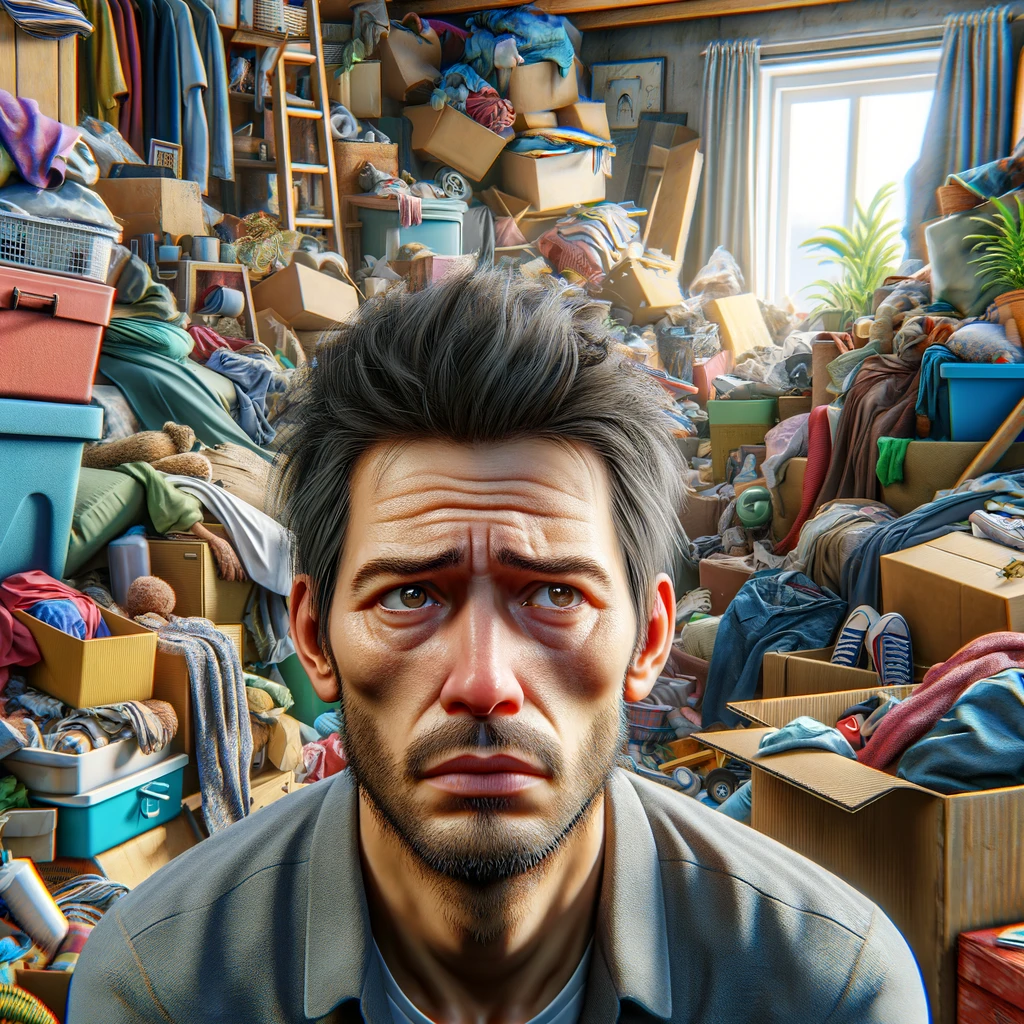Key Takeaways
-
Living with a hoarder causes significant psychological distress, including stress, anxiety, depression, and feelings of helplessness, which can lead to lasting emotional and health problems for residents.
-
Hoarding environments pose serious physical health risks, including respiratory problems, allergies, infections, and an increased likelihood of injuries due to clutter and compromised hygienic conditions.
-
Relationships and social dynamics are heavily strained in hoarding situations, causing conflict, tension, and social isolation for both the hoarder and family members, and coping strategies include seeking professional help, educating oneself, and setting boundaries.
The Psychological Impact of Living with a Hoarder
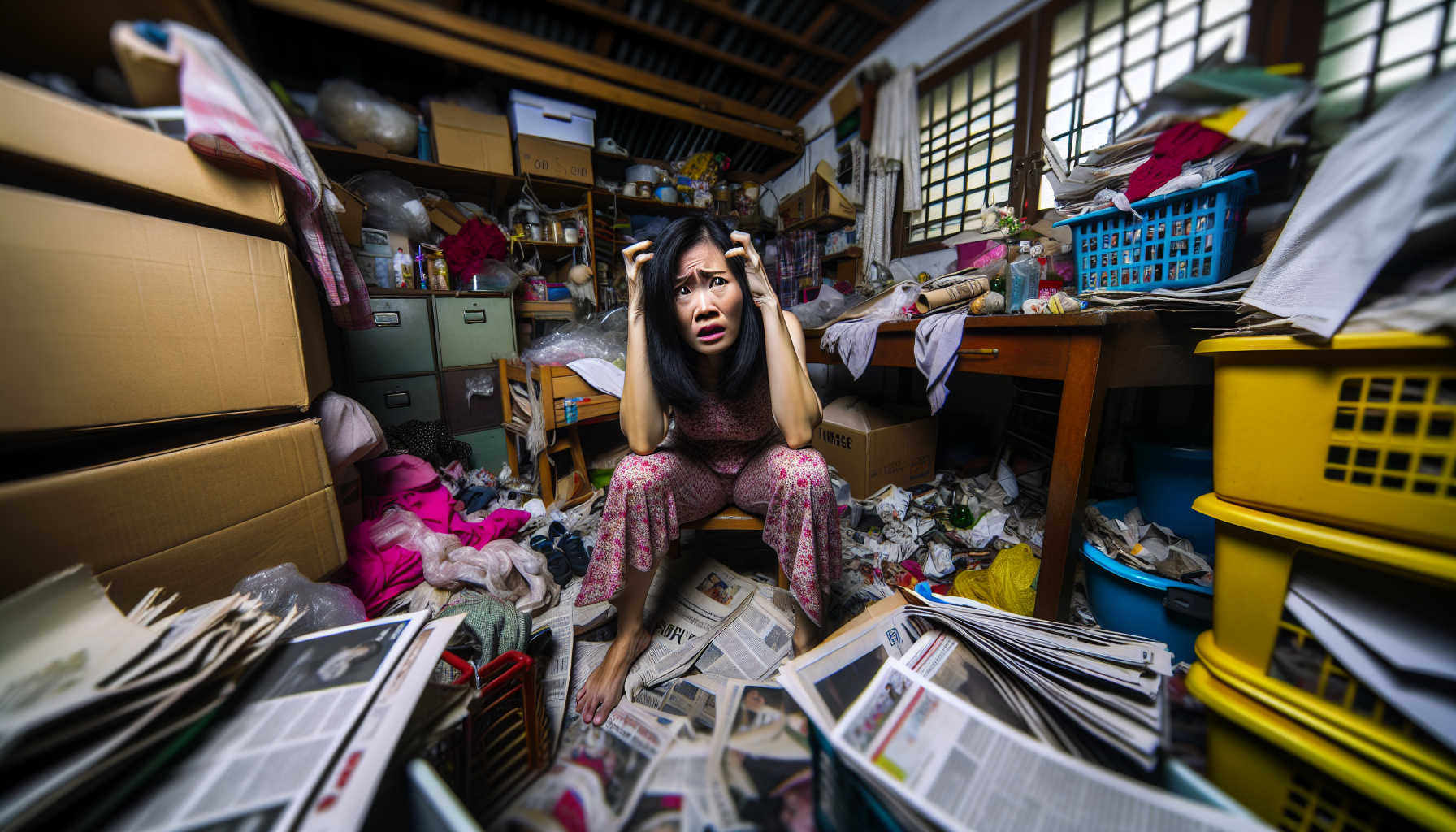
Picture living with someone suffering from a hoarding disorder, a condition recognized in the Diagnostic and Statistical Manual of Mental Disorders. This mental health problem transforms homes into mazes of clutter, where every inch is piled high with hoarded items. The hoarding ranges from excessive shopping to a persistent difficulty in discarding items, turning the hoarded home into a hub of mental and emotional strain for those with mental disorders, including obsessive compulsive disorder and mental illness.
Family members can find themselves caught in a psychological quagmire as the hoarding situation intensifies. The mental health of those living in hoarded homes deteriorates as the disorder progresses, often peaking by middle age. It’s not just the physical clutter, but the emotional debris that can leave lasting scars.
Stress and Anxiety
Waking up in a home that resembles an obstacle course rather than a safe haven is a common experience. The once-relaxing living room is now buried under mountains of stuff. The kitchen, once the heart of the home, now a repository for rotten food or unused appliances. The loss of livable areas triggers a surge of stress and anxiety, turning your home into a source of constant dread.
Financial burdens further add to the pressure. Maybe your loved one is spending beyond their means to feed their hoarding behavior. Or perhaps, the cost of managing the hoarding problem is draining your savings. Then there’s the family conflict, arising from the constant tug-of-war over control and space. This emotional turmoil can manifest as health problems, leading to a vicious cycle of stress and anxiety.
Depression
Feeling unloved or worse, rejected in favor of inanimate possessions, can be a harsh reality. It’s a harsh reality for those living with a hoarder. Each hoarded item feels like a reminder of your secondary importance, a blow to your self-worth. This emotional distress can soon morph into depression, a dark cloud that hangs over your life.
For spouses of hoarders, depression can become a constant companion. The hoarding situation in their home fuels feelings of despair, sometimes leading to severe depression or even suicidal ideation.
Adult children of hoarders too bear the brunt of this emotional toll. Resentment and feeling undervalued can trigger depression, which only intensifies with age as they reflect on their upbringing.
Helplessness
Imagine trying to influence a hoarder to change their behavior, only to hit a brick wall of resistance. Each failed attempt chips away at your hope, leaving you feeling helpless. You watch your living conditions deteriorate, but your hands are tied. This sense of helplessness can be overwhelming, leading to emotional distress.
For children of hoarders, this feeling of helplessness is heightened. They watch their family dynamics change, straddling two worlds – the public one where they put on a brave face, and the private one where they feel hopeless and abandoned. This dichotomy can leave long-term emotional scars, shaping their social relationships and self-perception as it can affect family members in various ways, especially for families affected by hoarding and their family history.
The Physical Health Consequences
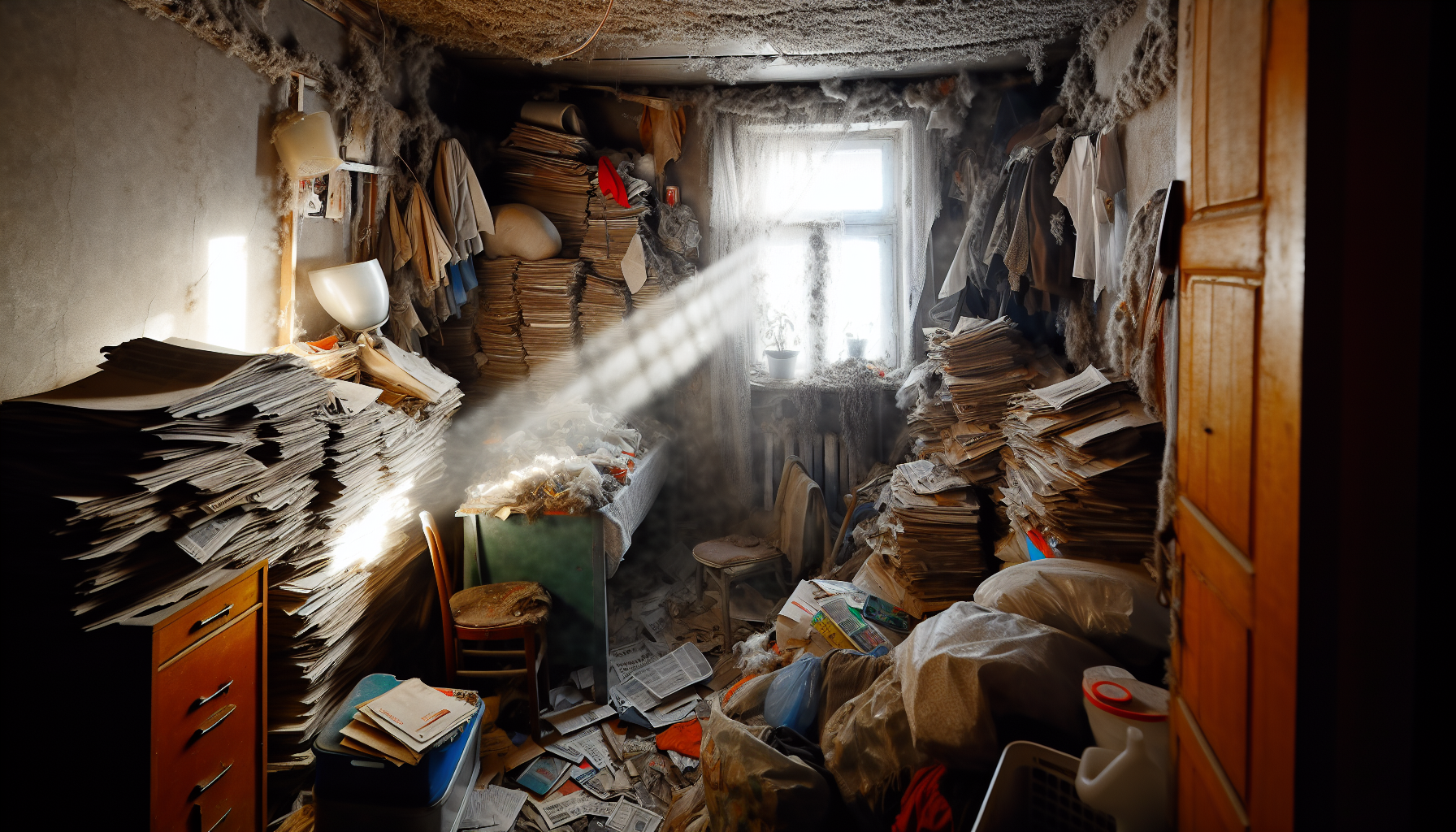
The ramifications of living with a hoarder go beyond psychological impact. The physical health consequences are just as real and alarming. Hoarded homes often pose a significant risk to health, with unhealthy living conditions, increased risk of accidents, and compromised hygiene.
Children who grow up in cluttered environments have a higher risk of:
-
accidents and injuries, such as fires or pest bites
-
respiratory health issues due to mold spores, dust, and pest droppings in the air
-
allergies and infections due to the breeding ground for pests in the clutter
Respiratory Problems
Imagine breathing in air filled with mold spores and pest droppings. This is the grim reality of living in a hoarded home. The lack of ventilation combined with the accumulation of clutter leads to mold and mildew growth, severely impairing air quality and causing respiratory issues.
The inability to clean thoroughly means pest droppings add to the toxic cocktail in the air. Inhaling these allergens can trigger allergic reactions and respiratory problems. Besides the visible clutter, it’s this invisible threat that makes living with a hoarder a serious health problem.
Allergies and Infections
The hoarded environment is a haven for pests. Cockroaches, mice, and rats find ample food and hiding spots amidst the clutter. The droppings and residue they leave behind can trigger asthma flare-ups and allergies. Some pests, like rodents, can even spread diseases, leading to serious respiratory conditions.
Exposure to dust and dirt is also a constant risk in a hoarded home. Breathing in these particles can increase the risk of developing allergies and infections. The risk is even higher for children and older adults, who have weaker immune systems, making them more susceptible to these health risks.
Increased Risk of Injury
Imagine navigating through a minefield of clutter, where one wrong step could lead to an accident. This is the reality in a hoarded home. The cluttered spaces restrict movement, increasing the risk of:
-
tripping or falling
-
getting trapped or stuck
-
objects falling and causing injury
-
fire hazards
-
unsanitary conditions
In extreme cases, these accidents can lead to serious injuries.
Unstable piles of items are another hazard. They can topple over at any moment, posing a risk of injury. If the clutter includes sharp or heavy objects, the risk is even higher. The home, which should be a safe space, becomes a danger zone, adding to the physical toll of living with a hoarder.
Relationship Strain and Social Isolation
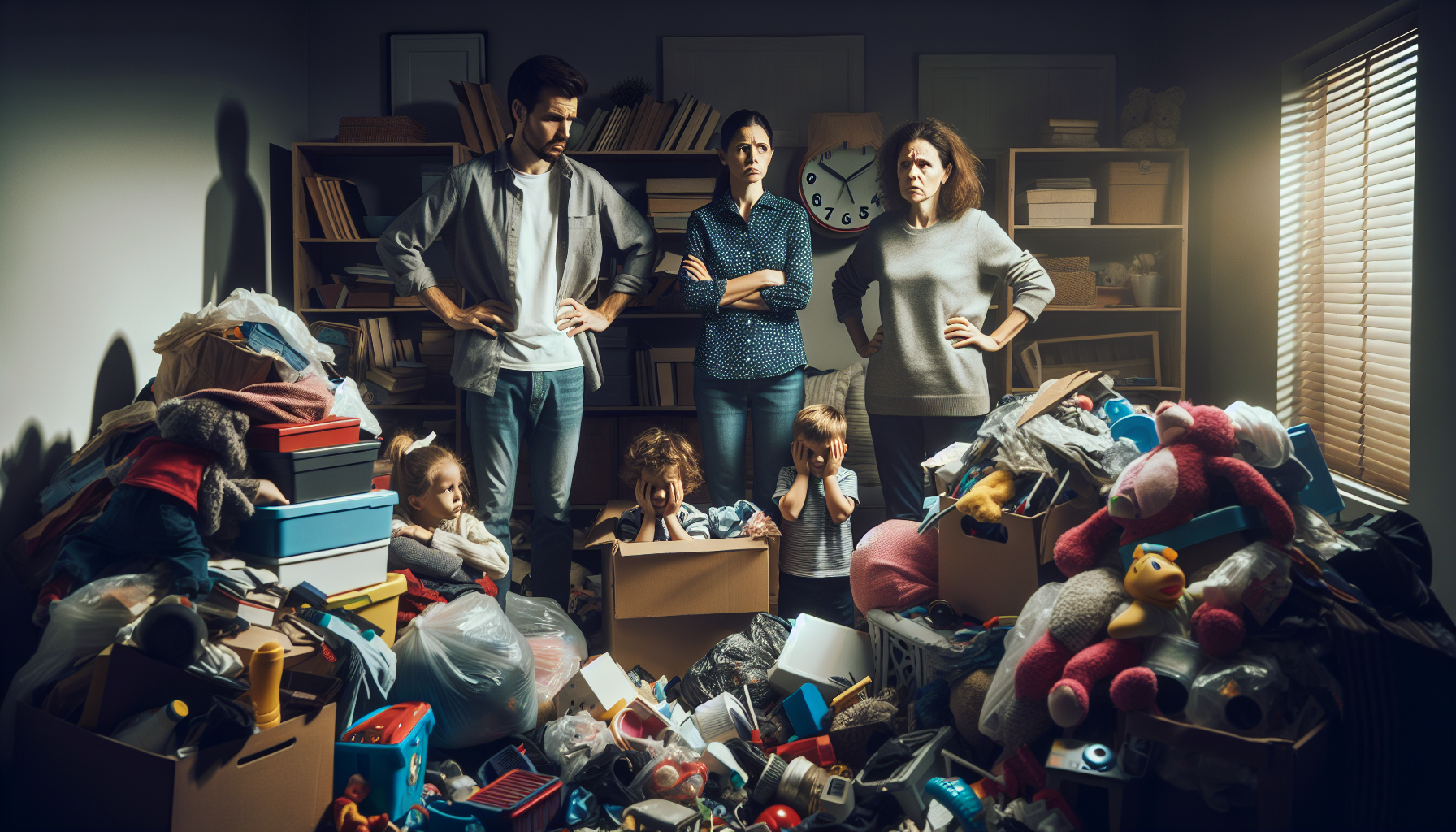
The effects of hoarding extend beyond the individual hoarder. It sends ripples through the family, straining relationships and leading to social isolation. As the hoarding escalates, family members may feel offended or abandoned. The hoarder’s unwillingness to part with their items can impact their sense of belonging and emotional well-being, causing further strain.
Social isolation is another consequence. Hoarders often avoid inviting guests over, either due to the embarrassment of their home’s state or to protect their hoarded items. This isolation not only impacts the hoarder but also extends to their family members. The spouse of a hoarder, for instance, may become socially isolated due to the hoarder’s reluctance to have guests.
Conflict and Tension
Living with a hoarder often leads to major family conflicts. As the clutter claims more and more space, family members find themselves squeezed out of living areas. The kitchen, living room, even the bedrooms become battlegrounds, causing friction and tension among each family member.
The hoarder’s emotional attachment to their possessions often leads to misunderstandings and conflict. Attempts to clean or organize the clutter without the hoarder’s consent can lead to arguments and a loss of trust. Over time, these conflicts can escalate, leading to broken relationships and even considerations of separation or divorce.
Social Isolation
The embarrassment of the home’s condition can lead to social isolation. Children of hoarders may avoid inviting friends over, leading to hidden living situations and impaired social development. This isolation can extend to other family members, preventing grandchildren from safely visiting their grandparents or causing spouses to feel isolated.
The hoarder’s reluctance to invite guests over further adds to the isolation. The shame and humiliation tied to the state of the home often outweigh the desire for social interaction. This isolation can lead to depression, creating a cycle of emotional distress that further isolates the hoarder and their family.
Coping Strategies for Family Members

There’s no denying the challenges of living with a hoarder. But it’s not a lost cause. There are coping strategies that can help manage the stress and anxiety. Seeking professional help, educating oneself about the hoarding disorder, and setting boundaries are some of the ways to cope.
These strategies are not just for the hoarder but also for their family members. Some strategies to cope with hoarding include:
-
Managing personal stress
-
Joining a support group
-
Building relationships through shared interests
-
Understanding the hoarder’s attachment to their items
These strategies can all contribute to coping with the situation.
Seeking Professional Help
Seeking professional help to seek treatment emerges as one of the most effective coping strategies for anxiety disorders. Therapies like cognitive-behavioral therapy (CBT) can help family members manage their stress and anxiety. Licensed therapists can also provide coping tips to handle the emotional turmoil.
Online therapy services offer a comfortable option for those hesitant to seek in-person help. Therapy, especially when combined with organizing strategies, can make a significant difference for those living with a hoarder.
Educating Yourself
Understanding hoarding disorder is a crucial part of the coping process. Knowing the difference between hoarding, collecting, and being messy helps put things in perspective. It’s important to comprehend that hoarding involves distress and impairment in daily activities, beyond just having a lot of stuff.
Learning about the reasons why people hoard, such as irrational beliefs about the importance of objects, can also help family members provide the right kind of support. The more you understand the disorder, the better equipped you’ll be to handle the situation with empathy and compassion.
Setting Boundaries
Setting boundaries is another important coping strategy. Establishing realistic expectations for the cleaning and healing process can relieve some of the pressure. It’s crucial to remember that improvements will take time, and there may be setbacks.
Establishing boundaries around the acquisition of new items can also mitigate further clutter. For instance, using a ‘marinating box’ for items that haven’t been sorted can prevent additional clutter in living spaces. Setting financial boundaries can also help manage the financial burdens caused by hoarding.
Supporting Your Loved One in Seeking Treatment
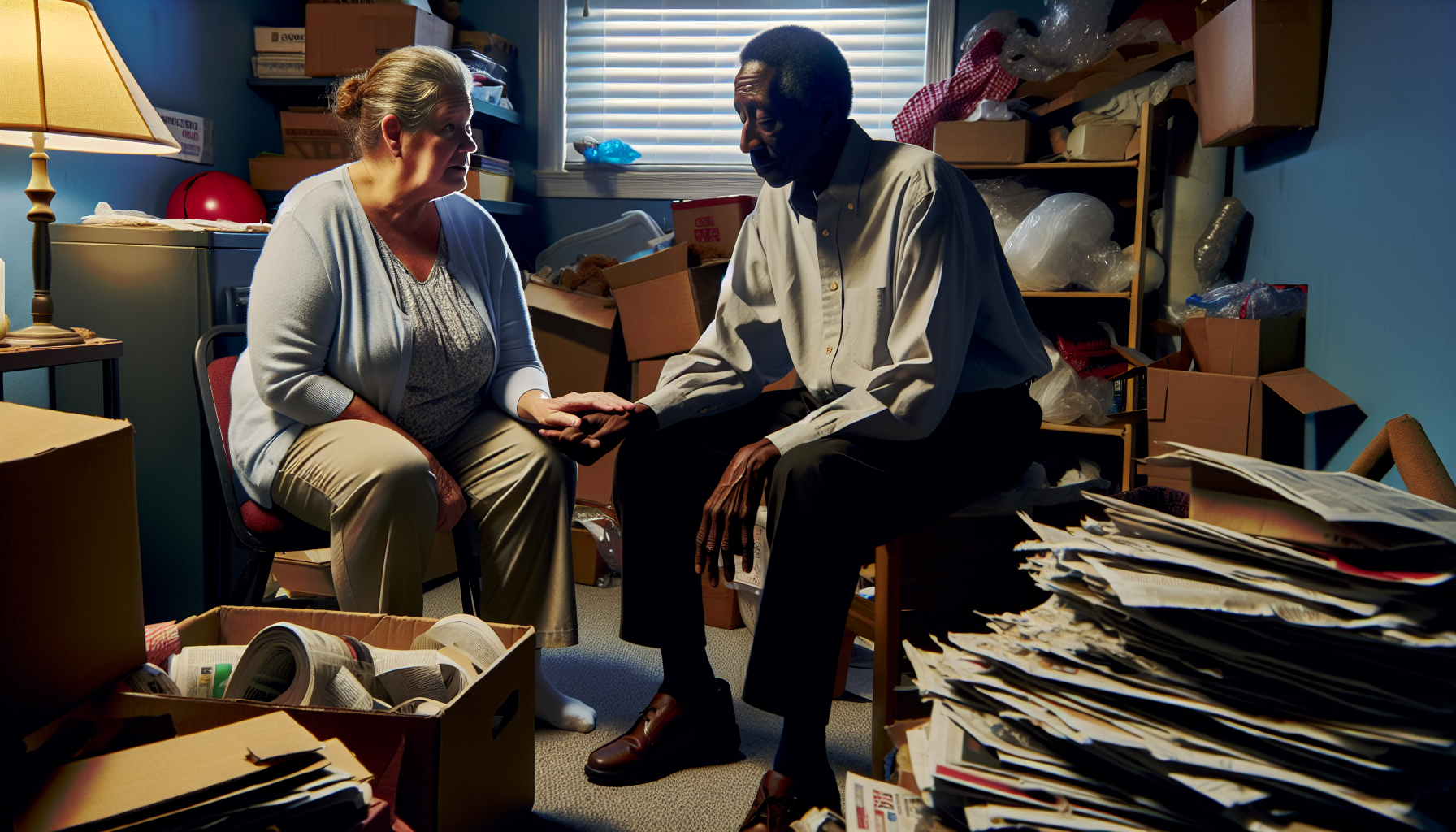
Facilitating a loved one’s treatment-seeking process calls for delicacy. It requires empathy, patience, and persistence. It’s important to approach the conversation gently, without putting pressure on the hoarder. Show them that you’re there to support them, not to control them.
Encouraging the hoarder to seek professional help is a crucial step. But it’s equally important not to clean up after them or remove items without their consent. Such actions can reduce their motivation to address the problem independently and can lead to trust issues.
Approaching the Conversation
Starting the conversation about treatment can be challenging. It’s important to approach it with gentleness and empathy, avoiding accusatory language. The conversation should show genuine concern for the person’s well-being and not come across as an attack on their lifestyle.
Choosing a comfortable and private setting for the discussion can make a big difference. Encouraging the hoarder to seek professional help should be done supportively and without pressure. It’s crucial to reassure them that they have control over their decisions and that recovery is a journey, not a destination.
Identifying Resources
Once the conversation about treatment has started, it’s important to identify resources that can provide support. Cognitive-behavioral therapy (CBT) is the primary treatment for hoarding disorder. To treat hoarding disorder effectively, there are online resources like the International OCD Foundation and Hoarding Cleanup that can help locate therapists, treatment programs, and support groups for treating hoarding disorder.
Knowing where to seek help can empower the hoarder to take the first steps towards recovery. Professional organizers experienced in dealing with hoarding disorder can also provide practical help in decluttering and organizing the home.
Being Patient and Persistent
Patience and persistence are key in supporting a loved one through the treatment process. Recognizing and celebrating small victories can keep the hoarder motivated. It’s important to reassure them that setbacks are a normal part of recovery, and they should not be discouraged by them.
Persistent emotional support and continual reminders of the long-term benefits of treatment can also be beneficial. It’s crucial to ensure that the support provided does not enable the continuation of hoarding behaviors. Instead, it should empower the hoarder to take responsibility for their actions and make positive changes.
Summary
Living with a hoarder can be an emotional rollercoaster. It can lead to stress, anxiety, depression, feelings of helplessness, strained relationships, social isolation, and a host of physical health problems. But remember, it’s not a lost cause. There are coping strategies that can help manage the situation.
Seeking professional help, educating oneself about the hoarding disorder, and setting boundaries are some of the ways to cope. Supporting a loved one in seeking treatment requires empathy, patience, and persistence. It’s a journey, and like any journey, it has its ups and downs. But with the right support and resources, it’s a journey that can lead to healing and recovery.
Frequently Asked Questions
How do you cope with living with a hoarder?
Support is essential in managing your own feelings and learning coping strategies while living with a hoarder. Seek professional help and express the impact of your loved one’s hoarding disorder on your life. It’s important to respect each other’s boundaries and address the issue together while also giving them space. Talking therapy can also be beneficial.
What can spouse of a hoarder do?
Support your spouse by avoiding enabling their hoarding habits, gently nudging them to declutter, and offering to organize items together. Additionally, engage in activities that are not focused on hoarding to provide non-judgmental support and help them change their behaviors.
Can a minimalist live with a hoarder?
Living with a hoarder as a minimalist requires time, compromise, empathy, and a willingness to let go of a little bit of control in order to find a balance. May 16, 2021.
Can living in a hoarder house make you sick?
Living in a hoarder house can make you sick due to poor indoor air quality and health hazards such as mold, infestations, and respiratory problems. These conditions can be particularly dangerous for those with compromised immune systems.
What is the psychological impact of living with a hoarder?
Living with a hoarder can lead to stress, anxiety, depression, and feelings of helplessness, impacting the mental well-being of individuals. It’s important to seek support and create boundaries in such situations.

